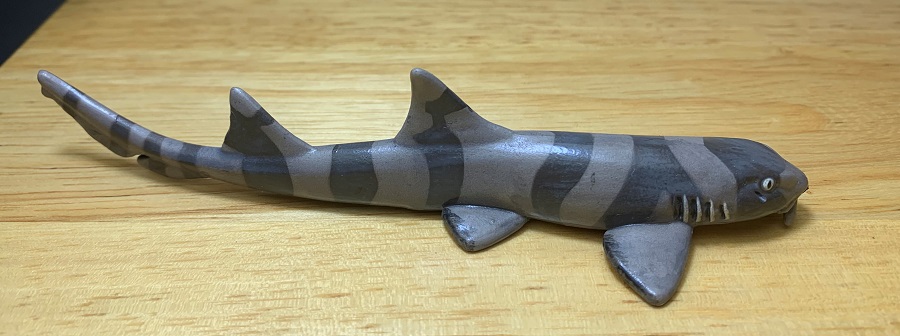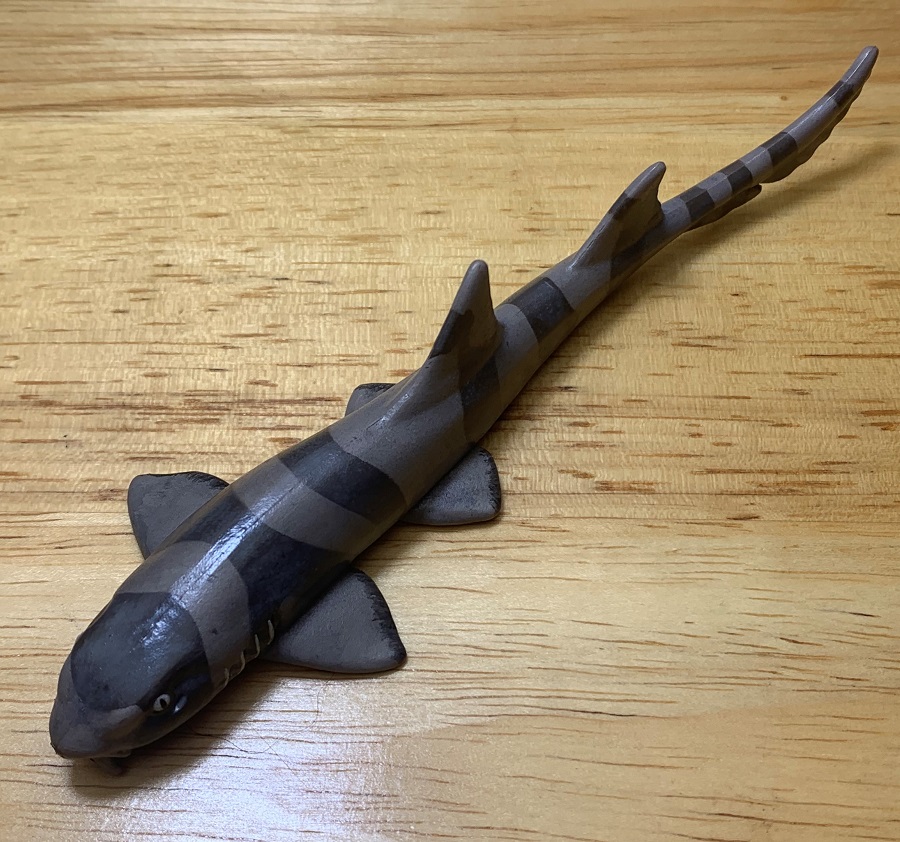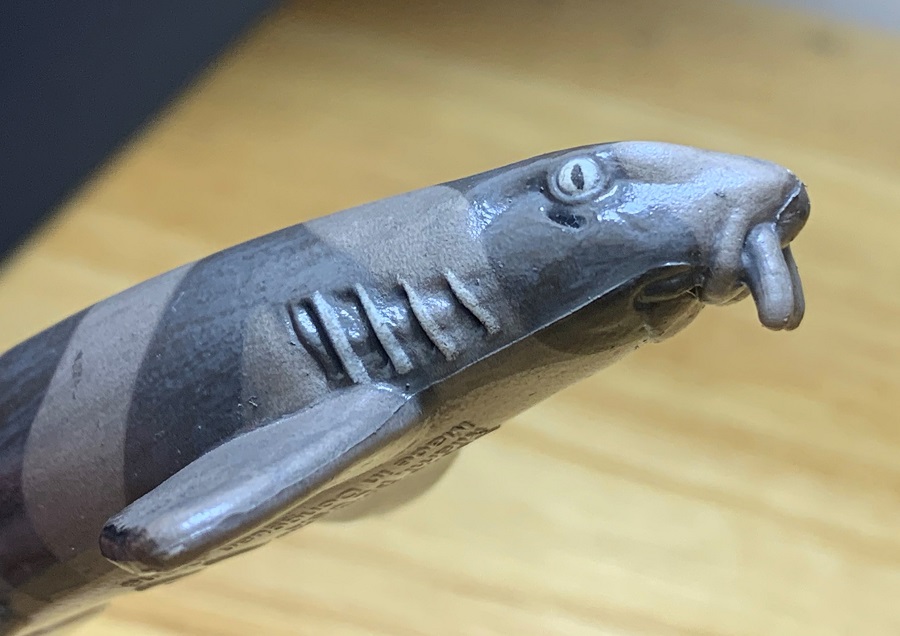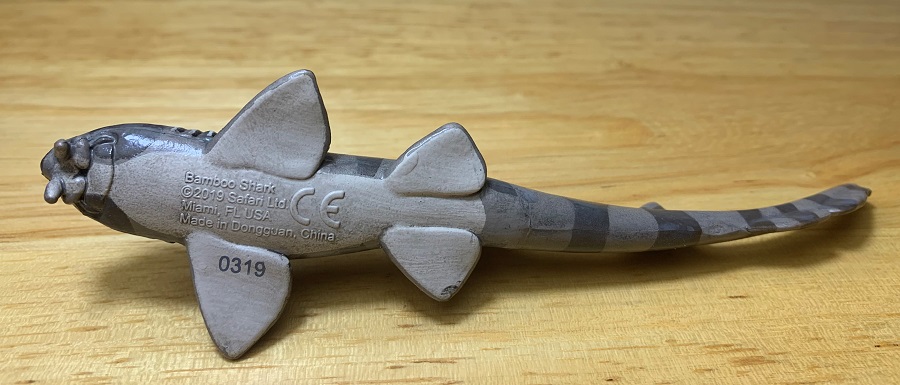Bamboo sharks, also less glamorously known as longtail carpet sharks, belong to the family Hemiscylliidae within the order Orectolobiformes (carpet sharks). This makes them close kin to such familiar sharks as the whale, nurse, and zebra sharks. All of them are found in the tropical Indo-Pacific and the largest members of the family only reach about 4’ (1.2 meters). Because of their small size, docile and sedentary nature, and ability to live in confined spaces like tide pools and coral beds, these are some of the best suited sharks for home and public aquaria. Bamboo sharks are split into two genera, Hemiscyllium and Chiloscyllium but it’s only really the latter that are referred to as bamboo sharks. The genus Hemiscyllium contains the various species of well-known epaulette sharks.

For 2019, Safari Ltd. chose to include this unlikely shark in their Wild Safari Sea Life line of toys. Although Safari sharks don’t always excel in accuracy, they are still among the best shark toys produced by any toy company, with a species selection unlike any other. The bamboo shark is a nice addition to their lineup but with seven species in the Chiloscyllium genus, which species of bamboo shark is it?

Safari only markets this toy as a bamboo shark, and to make matters worse the Safari website makes no mention of the species it is or even which genus it belongs in. The web site does mention that the toy represents a juvenile, as indicated by the brown banding running down its body. In a way, this further complicates things, because now we must identify a juvenile animal. So, for this identification I actually had to crack open a book, which is rarely needed in the age of information, but I always welcome the opportunity. In this case I used the Princeton Field Guide to Sharks of the World.

I’ve concluded that this shark is a brownbanded bamboo shark (Chiloscyllium punctatum). As adults these sharks have no patterning, but they do as juveniles. Many bamboo sharks have this patterning as juveniles but not all of them do, so some species can now be eliminated. Additionally, the bands aren’t edged in black, and no additional spotting is present, and this eliminates some other species as well. Lastly, there are no ridges running down the body, again eliminating some bamboo shark species. That the brownbanded bamboo shark is common in public aquaria and thus easy to observe or find references for all help seal the deal.

With that out of the way, we can finally look at the figure itself. The figure measures 5.25” (13.3 cm) while the actual brownbanded bamboo shark reaches a length of 41” (1.04 meters) which would put the figure at 1/7 in scale. That’s an adult size though, scaled down from a hatchling the toy becomes a 1/1 scale figure. This definitely means it doesn’t scale well with other Safari Ltd. shark toys, but I personally appreciate life sized figures when they’re practical.

The toy nicely illustrates the anatomy of bamboo sharks, being long and somewhat tube shaped, with an exceptionally long tail and dorsal and anal fins set far back on it. The origin of the 1st dorsal is over the front half of the pelvic fin bases, as it should be, and also has a slightly concave rear margin. These features also help identify this as a brownbanded bamboo shark. It might appear as though the anal fin is omitted but it’s there, it’s just so close to the caudal fin that you might think it was a part of it.

Five gill slits are present but only four of them are painted, the fourth and fifth slits are so close together that it can be difficult to discern them, but this too is accurate. Large spiracles are sculpted under the eyes, which would help aid the shark in breathing while resting motionless on the seabed. The mouth is nicely detailed, complete with a set of barbels. The absence of claspers means that this toy represents a female.

The figure is painted with a two-tone brown paint job in a banded pattern and a pale underside. The eyes are yellow with elliptical black pupils. Juveniles of this species often have black speckling but that’s omitted here and looking at pictures online the speckles aren’t obvious on the species anyway.

The Safari Ltd. bamboo shark is a fantastic representation of its species, it’s just a shame that Safari didn’t market it as such. That said, it’s also a fantastic representation of bamboo sharks in general which are neglected in our hobby. Looking on eBay I can’t find any other bamboo shark figures and if there are then none of them are as easily obtainable as this one. The Safari bamboo shark is still in production and retails for about $7.50. Make sure you pick one up to help flesh out your shark collection, even if it looks a little silly displayed next to them.
Disclaimer: links to Ebay and Amazon on the AnimalToyBlog are affiliate links, so we make a small commission if you use them. Thanks for supporting us!




At what stage would you say this is? Juvenile? Doesn’t strike me for a newborn, but clearly not an adult.
I would say with how bold the banding is that it’s not quite a newborn but still quite young. Closer to a newborn than to an adult.